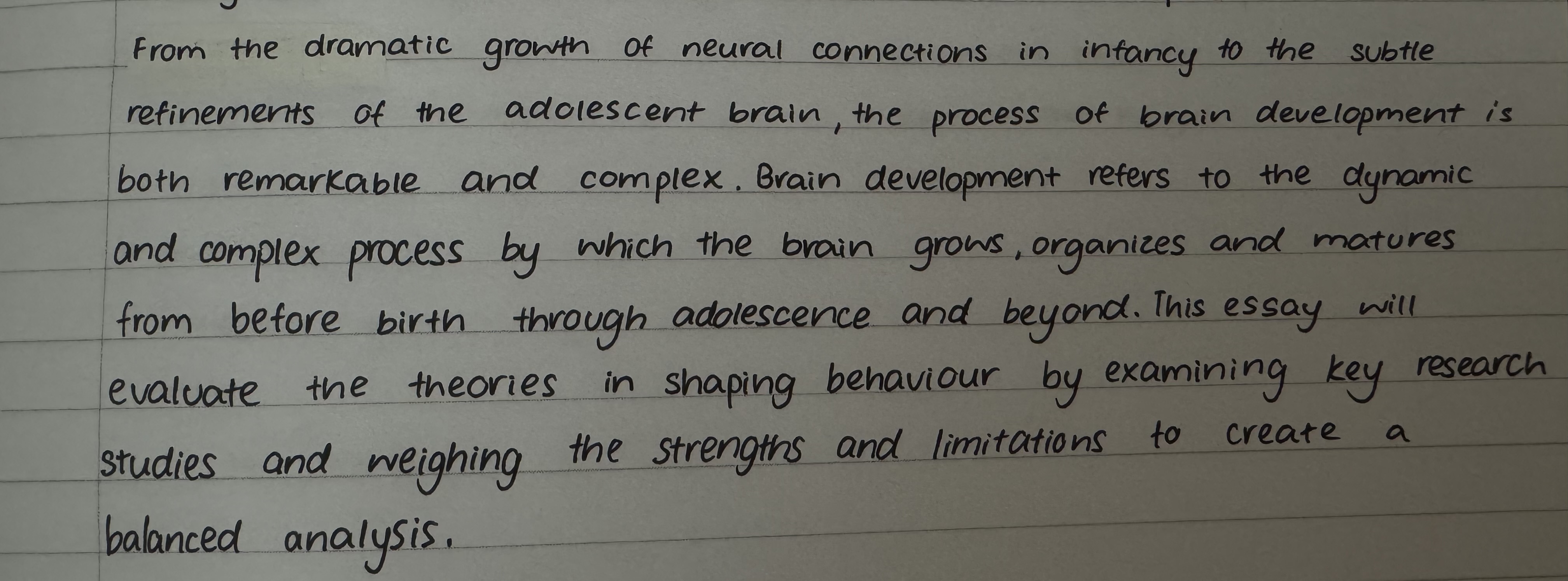Theories of brain development
1/13
Earn XP
Description and Tags
Developmental psychology: Evaluate one or more theories of brain development.
Name | Mastery | Learn | Test | Matching | Spaced |
|---|
No study sessions yet.
14 Terms
Piaget’s Theory of cognitive development aim
To understand how children’s thinking and reasoning develop over time
identifying the stages through which children progress as their cognitive abilities mature and to demonstrate that children think differently from adults
Piaget’s Theory of cognitive development procedure
He developed his theory through naturalistic observation, clinical interviews and a series of ingenious tasks and experiments with children
Observed his own children as well as others, presenting them with problems and questions to assess their reasoning abilities
Used tasks such as pouring water into differently shaped containers and hiding objects to see if infants searched for them (object permanence) to explore how children’s thinking changed with age
Piaget’s Theory of cognitive development findings
Children progress through distinct stages of cognitive development, each characterized by different thinking abilities, from sensorimotor to formal operational stages.
Sensorimotor Stage (Birth–2 years): Infants learn through sensory experiences and actions. They develop object permanence which is the understanding that objects exist even when not seen
Preoperational Stage (2–7 years): Children begin to use symbols and language but lack logical reasoning. They are egocentric and struggle to see perspectives other than their own
Concrete Operational Stage (7–11 years): Logical thinking develops, and children understand concepts like conservation and reversibility. They can take others’ viewpoints and classify objects
Formal Operational Stage (12 years–adulthood): Abstract, hypothetical, and systematic thinking emerges. Adolescents can reason about complex problems and consider multiple variables
Strengths of the Piaget’s Theory of cognitive development
Influence on education by highlighting the developmental stages that inform teaching methods, and provided testable hypotheses about cognitive milestones, enabling a foundation for further research in cognitive development. It emphasizes the active role of children in their learning processes.
Limitations of the Piaget’s Theory of cognitive development
Naturalistic observations and clinical interviews introduced potential researcher bias and subjectivity. Additionally, the theory may underestimate children's cognitive abilities and doesn't account for cultural differences in cognitive development. Relied on small, non-diverse samples (e.g., observations of his own children), raising questions about generalizability
Ethical considerations of the Piaget’s Theory of cognitive development
Lack of Informed Consent: Piaget’s use of his own children as subjects without their consent violates modern ethical standards, though norms were less defined in his era
Researcher Bias: As both parent and observer, Piaget’s interpretations may have been influenced by personal relationships, compromising objectivity
Privacy Concerns: Detailed public documentation of his children’s development raised privacy issues, though this was not regulated at the time
Vygotsky’s Sociocultural Theory aim
To explain how cognitive development is shaped by social interaction, cultural context, and the use of language and cultural tools
Vygotsky’s Sociocultural Theory procedure
Involves collaborative learning, where children engage with more knowledgeable others in a social context to acquire new skills and concepts.
Vygotsky did not conduct a single, classic experiment but developed his theory through:
Naturalistic observations and clinical interviews with children23.
Analysis of children’s language use, play, and problem-solving in social contexts
Comparative studies of children from different cultures to examine the influence of cultural tools and practices
He introduced key concepts such as the Zone of Proximal Development (ZPD), scaffolding, and the role of the More Knowledgeable Other (MKO)
Vygotsky’s Sociocultural Theory findings
Emphasizes the importance of social interaction and cultural tools in cognitive development, highlighting how children learn through guided participation and collaboration.
Strengths of Vygotsky’s Sociocultural Theory
Explains cultural differences in cognitive development and highlights the importance of environment. Addtionally, there is an educational impact by informing collaborative learning, scaffolding, and differentiated instruction in classrooms
Limitations of Vygotsky’s Sociocultural Theory
Critiques include a lack of empirical testing as Vygotsky’s theory is broad and conceptual, with fewer specific experiments compared to Piaget. To add on, there is less emphasis on innate maturational processes and individual differences in cognitive development
Ethical considerations of Vygotsky’s Sociocultural Theory
Naturalistic and observational methods: Generally low risk and ethically sound, as they involve observing children in real-life social and educational settings
Respect for cultural diversity: The theory values and respects different cultural practices and learning environments
Introduction

Conclusion
Both Piaget’s Theory of Cognitive Development and Vygotsky’s Sociocultural Theory offer valuable but distinct perspectives on brain development.
While Piaget focuses on the individual’s cognitive construction and stage-based progression, Vygotsky centers on collaborative learning, scaffolding, and the zone of proximal development as engines of cognitive growth
Both theories agree that children are active participants in their learning and that development is a dynamic process, but they differ on the relative influence of biological maturation versus social interaction
Evaluating these theories together shows that brain development is best understood as an interplay between innate biological processes and rich social environments.